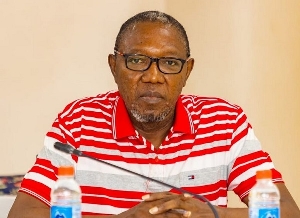Opinions of Thursday, 7 December 2023
Columnist: Elvis Adjei-Baah
Charting a new strategy to address housing demands: Why the revised affordable housing programme should be a government's priority project
Research from the Ghana Statistical Service (GSS) indicates that the country’s
housing deficit in the last 50-year period continually witnessed an upward trend from a figure of 1 million to 2.8 million from 1950 to 2010. However, the 2021 Population and Housing Census Data on Structures, Housing Conditions and
Facilities as presented by the GSS reveal a reversal in the housing deficit by
33%, approximately a 1.8million housing deficit.
Given this, available research indicates that close to 200,000 affordable housing units need to be produced every year over the next 10 years to be able to wipe out the huge deficit. While this is an obvious challenge, it also presents the government and private sector with a great opportunity to invest in the provision of affordable housing.
It is based on the foregoing that the Government of Ghana through the
Ministry of Works and Housing initiated a revised National Affordable Housing Programme dubbed: ‘My Home My Peace’, which adopts a programmatic approach to tackle the affordability gap and improve access to housing for Ghanaians.
The approach or strategy for the revised national affordable housing
programme:
In this revised version, the Government will subsidize the housing units with land and infrastructure, which is to absorb a critical component of the construction cost. That is, each of the components that contribute to the cost of housing units land, and on-site infrastructure such as roads, drainage, electricity, and water have been identified and provided for by the Government. This is expected to significantly subsidize the cost of housing units and reduce it by at least 40%.
The private sector will complement these efforts by raising funds to build the
apartments on a cost-recovery basis. With this approach and the appropriate
mortgage arrangements in place, these housing units will be affordable to
Ghanaian workers and ultimately address the supply side of the housing market.
The initial project under this revised programme entails the construction of 8,000 housing units on 203-acre land in Pokuase/Amasaman in the Greater Accra
region, and 6,000 housing units on 200-acre land in Dedesua in the Ashanti
Region. Suffice it to say that work has already commenced at the Pokuase/Amasaman Project site following thorough feasibility studies, including assessments of environmental, social, property, and traffic impacts, as well as housing stress and financial analysis.
The developers for the programme:
Five (5) developers comprising both local and international companies with
several years of experience and expertise, as well as resources have been
selected to participate in the programme. The Five developers are as follows:
Rehoboth properties
State Housing Company Limited
Devtraco Group Limited
FrankPauls Ventures Company Limited
Douja Promotion Addoha Groupe Limited
The cost implications and expected payment plans:
To ensure the subsidy is transferred to buyers of the housing units, the
government has worked with the selected developers to agree on a price ceiling
for the various housing units. Developers cannot sell above the agreed price
ceiling, however, they can sell below the agreed price ceiling.
Beyond the government’s subsidy, the project provides flexible payment options
to accommodate the different financial capacities of potential buyers. Three
payment models have been identified:
Mortgage payment: This model will allow buyers to secure housing units
through mortgage financing under the model being run by the National Homeownership Fund (NHF). This option would be beneficial for buyers who
require long-term payment plans and wish to spread their payments over an
extended period. The NHF will collaborate with financial institutions to facilitate the provision of mortgage financing to eligible buyers. Similarly, interested buyers can make private mortgage arrangements with their respective banks.
Scheduled payment plan: This model will enable buyers to make regular
instalment payments towards the purchase of the housing units based on agreed
terms.
Outright payment: This model will cater for buyers who can afford to make a lump-sum payment for their housing units based on agreed terms.
Programme's unique features:
Master plan:
The programme has an approved Master Plan that responds to the needs of a
wider catchment area far beyond Pokuase to include the 4 adjoining Metropolitan
/ Municipal / District Assemblies. Facilities such as football fields, tennis courts, volleyball courts, basketball courts, swimming pools, and children’s playgrounds will serve the adjoining communities. In effect, the aim is to build a liveable sustainable community and not just affordable houses.
Concept of affordability:
As a strategy to achieve the concept of affordability, the government collaborated with selected private developers to ensure that the apartments are
affordable to Ghanaian workers. By so doing, the Government is providing land, on-site infrastructure as well as mortgage subsidies to ensure affordability, while the developers provide the apartments on a cost-recoverable basis.
Private developers:
This is the first Government Housing Project that has successfully collaborated
with the private sector, with developers taking the burden of building the
apartments while the Government focuses on the acquisition and provision of
infrastructure.
Expanded scope of site infrastructure:
Unlike all the existing public housing projects, this particular project has redefined the scope of site infrastructure to go beyond roads drains water, electricity, and sewerage. Site infrastructure includes football fields that double as a community events centre and an array of sporting facilities - basketball court, volleyball court, swimming pools, children's play area, and police post.
Use of local building materials (Burnt-clay bricks):
This project has a high content of burnt-clay bricks to be used at the three
different levels – for a perimeter fence wall of 200-acre coverage, for external
walls of the apartments, and also for paving the walkways. Beyond this, the
ministry is using this project in collaboration with the Brick Producers Association and BRRI to path a strategy for the sustained growth of the local building materials industry.
Feasibility studies:
This is the first Government Housing Project which has been subjected to a
detailed feasibility study as a pre-condition for funding by the Ministry of Finance. Feasibility studies done covered environmental impact assessment, social impact assessment, property impact assessment, traffic impact assessment, housing stress analysis, and financial analysis.
Estate maintenance and management:
Unlike previous Government Housing Projects where estate maintenance and
estate management is considered as an after-thought or completely ignored,
this project is taking off with a comprehensive set of estate management
provisions in place all led by the private sector.
Sewerage treatment facilities:
The project is supported with mini sewerage treatment plants, which will initially be maintained by the service provider. However, the Ministry is using this project to build capacity within the Ga North Municipal Assembly in the operation and maintenance of sewerage treatment plants. Through this arrangement, the Ga North Assembly can become an incubator for other relevant Assemblies to also attain capacities.
Public transport strategy:
The Ministry will be piloting a public transport programme with the Pokuase
Housing Project. Selected bus companies such as Metro Mass etc. will be
engaged to operate a shuttle service for the estate to reduce the anticipated high volume of cars, taxis, and Uber services.
Carbon credits strategy:
This project seeks to be favourable in terms of Carbon credit accumulation.
There is extensive landscaping along the road corridors and also public open
spaces, children’s play areas. In addition, the extensive use of eco-friendly burnt-clay bricks all go to improve the carbon credit status of the estate.
Even though, successive governments have over the years come up with various
policy interventions aimed at addressing the challenges associated with the
country’s quest to provide affordable housing to the citizenry especially the low to middle-income earners, most of these interventions have not been as impactful as they should.
It is against this background that this revised strategy which has been carefully planned with expert and technical considerations throughout the
process, most importantly incorporating all the foregoing unique features for
sustainable housing development should be given the needed priority status by
the government.
The author is the Head of Public Relations at the Ministry of Works and
Housing.













